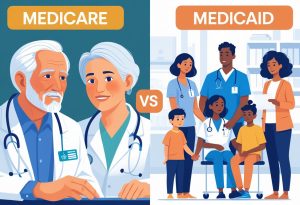Medicare is a federal health insurance program designed to help older Americans manage the rising cost of medical care. It exists to provide security — not just in how healthcare services are paid for, but in knowing you’ll have coverage when you need it most. For many people approaching retirement, it’s one of the most important benefits they’ve earned through a lifetime of work.
But understanding Medicare isn’t always easy. The system is complex. The rules keep changing. And there’s no shortage of misinformation floating around — from misleading advertisements to half-right advice from well-meaning friends and relatives. It’s no surprise so many people feel overwhelmed as they approach their 65th birthday.
You deserve better than that. Medicare was created to take care of you, not confuse you. But the way it’s often presented leaves hard-working Americans unsure of what they’re signing up for or whether they’re getting the best value. You’ve spent decades contributing to this benefit through payroll taxes. It should support you now, not leave you guessing.
This guide is here to change that.
We’ll walk you through the basics of Medicare in clear and plain terms. No fast-talking sales pitches. No unclear fine print. Just the facts you need to make confident decisions about your healthcare coverage, starting with an honest look at what Medicare is and why it exists.
Here’s What Medicare Is Really About
- Comprehensive Care: It covers hospital stays, doctor visits, preventive services, and prescription drugs, helping protect you from major out-of-pocket expenses.
- Support You’ve Earned: If you’ve worked and paid into Social Security for at least 10 years, you’ve already paid into Medicare. It’s not a handout — it’s a benefit you helped build.
- Reliable Coverage: When enrolled properly, Medicare gives you predictable healthcare access with fewer of the surprise bills seen in private, underinsured plans.
You’ve worked too hard to be left confused by Medicare. Our goal is to give you the real information you can trust — not to sell you something, but to support you.
Understanding Medicare Eligibility Criteria
Getting a handle on Medicare starts with knowing exactly who qualifies. Too many people hit age 65 without clear guidance, then scramble trying to figure out what they’re eligible for and when. Let’s break it down so there’s no guessing.
Who’s Eligible for Medicare?
Most people qualify for Medicare at age 65. If you’ve worked and paid Medicare taxes for at least 10 years (or 40 quarters), you’re typically entitled to premium-free Part A, which covers hospital services. You can still qualify even if you haven’t personally worked that long, as long as your spouse has.
But age isn’t the only path. Younger individuals with certain disabilities or permanent kidney failure may also qualify. For example, if you’ve been receiving Social Security Disability Insurance (SSDI) for a set period, you may become eligible for Medicare before turning 65.
Medicare Enrollment Periods
- Initial Enrollment Period (IEP): Starts 3 months before the month you turn 65, includes your birthday month, and ends 3 months after. A 7-month window to avoid delays or penalties.
- Special Enrollment Period (SEP): If you’re still working and have employer coverage when you turn 65, you may qualify for a special period to enroll later without penalty.
- General Enrollment Period (GEP): If you miss your IEP and don’t qualify for a SEP, you can sign up between January 1 and March 31 each year.
Avoiding Penalties
If you miss your IEP and don’t have qualifying coverage through work, you’ll likely pay lifetime penalties on your Part B and Part D premiums. These penalties add up fast and can’t be undone.
Medicare Coverage Options and Benefits Overview
Once you’re eligible for Medicare, the next step is understanding what it actually covers — and how to choose the right parts for your needs. Medicare isn’t one single plan. It’s split into parts, with each covering different types of care, services, and prescription drugs.
The Four Parts of Medicare, Explained Simply
- Part A – Hospital Coverage: Covers inpatient stays, skilled nursing facilities, hospice care, and some home health services.
- Part B – Medical Coverage: Includes outpatient care, doctor visits, preventive screenings, lab work, and more.
- Part C – Medicare Advantage: Private plans that bundle Part A and Part B, often with extra benefits like dental, vision, hearing, and sometimes Part D drugs.
- Part D – Prescription Drug Coverage: Standalone plans to cover prescription drugs, with monthly premiums, deductibles, and copays.
What Is “Original Medicare”?
Original Medicare is just Parts A and B. It’s run directly by the federal government and gives you access to any doctor or hospital in the country that accepts Medicare. This option offers flexibility but doesn’t include drug coverage or protection from high out-of-pocket costs.
Should You Add Extra Protection?
If you go with Original Medicare, you can add:
- A Part D drug plan to cover prescriptions.
- A Medigap (Medicare Supplement) plan to help pay deductibles, copays, and coinsurance.
Medicaid vs. Medicare for Seniors: Key Differences and Eligibility
The Basics: Who Each Program Is For
- Medicare: For people age 65+ or younger with qualifying disabilities. Based on age/work history, not income.
- Medicaid: A need-based program for low-income individuals and families, including seniors with limited income and assets.
What Each Program Covers
- Medicare: Hospital stays, doctor visits, outpatient services, prescriptions, and more.
- Medicaid: Services Medicare doesn’t fully cover, like long-term nursing care, personal assistance, dental, vision, and transportation.
Qualifying for Both: Dual Eligibility
Some seniors qualify for both programs. Medicare pays first, and Medicaid may help cover remaining costs like premiums, copays, and uncovered services.
How to Enroll in Medicare and What to Expect
Step-by-Step: How to Get Started
- Know your enrollment window (7-month IEP).
- Decide how you want to enroll (online, phone, or in person).
- Choose your coverage (Original Medicare, Advantage, Medigap, Part D).
- Gather documents (Social Security number, DOB, work history, insurance info).
Common Mistakes to Avoid
- Waiting too long to enroll.
- Assuming Medicare covers everything.
- Relying on secondhand advice.
Finding Reliable Support and Ongoing Assistance
Navigating Medicare isn’t just a one-time event. The choices you make at 65 can follow you for years — and healthcare needs rarely stay the same. That’s why having a dependable, experienced guide matters.
What to Look for in a Medicare Advisor
- Full-time commitment and availability year-round.
- Education over persuasion — clear explanations, no pressure.
- Ongoing support with annual plan reviews.
- Independence — access to multiple plan options.
Tips for Maximizing Medicare Value and Avoiding Common Pitfalls
Review Your Coverage Every Year
Plans change annually. Use the Annual Enrollment Period (October 15 – December 7) to review your plan and ensure it still meets your needs.
Pay Attention to Drug Coverage
Drug formularies and costs can shift. Check your plan’s coverage each fall and review pharmacy options to avoid overspending.
Watch for Out-of-Pocket Risks
Deductibles and copays can add up. Consider Medigap or track your Advantage plan’s annual MOOP carefully.
Don’t Assume You’re “All Covered”
Original Medicare doesn’t cover dental, vision, hearing, or long-term care. Plan ahead for these needs.
Watch for Scams and Misleading Ads
Be cautious of flashy promises and fraud attempts. Never give out your Medicare number to strangers.
Stay Informed with Ongoing Guidance
Medicare works best when you stay engaged. Regular check-ins and expert support can save you stress, time, and money.
You’ve earned Medicare through decades of hard work. Don’t leave your healthcare plan to chance.
Download Our Free Checklist
Want a printable version of the Open Enrollment checklist?
Includes
- Timeline with all important dates
- Document checklist
- Questions to ask before choosing a plan
- Comparison worksheet
- Contact information for resources
Print it out. Check off items as you go. Make notes in the margins.






